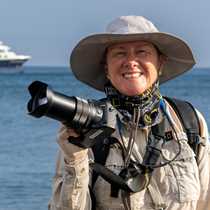Sierra Negra Volcano and Villamil, Southeast Isabela Island
A wild game of soccer took place this afternoon on the soft white sand of the beach town of Villamil, southeastern Isabela Island. While the non-participants stood or sat to one side with drinks in hand cheering the players, most of our younger guests took part in the match for the better part of an hour as the sun lowered on the western horizon. It was a grand finale to an active day that began after breakfast with a pick-up ride up the flank of Sierra Negra Volcano, an impressive, and today looming, volcano to the west of town.
The four-door pick-ups, which serve the town as the local vehicle of choice, took us past desolate expanses of lava outside of town, then gradually made their way up through greener pastures. They were especially verdant today! During the last few weeks, the heavy mists known as “garua” have finally began to fall on the upper slopes, giving respite to the farmers who have been preoccupied with an on-going drought for quite a few months by now. The “mist” was in fact a light rain, and with the higher elevation soon dampened and cooled the riders in the back, but did not dampen spirits. Only by walking up to and then around the rim did the “farthest and furthest” finally reach drier paths and a view of the impressive crater floor so recently re-paved with a layer of fresh lava this past October.
“Pele’s Hair,” filamentous strands of lava frozen in time by the winds during an eruption, was found among the chips of shiny cinder where we stopped to look at the view. Inside the crater was impressive, but outside the crater was spectacular. We could see clearly down the outer slopes of the volcano to the Isthmus of Perry, the narrow neck of land separating the southern two volcanoes of Isabela Island from the northern three and a half. The two bays, Cartago Bay to the east and Elizabeth Bay to the west sparkled in clear air, but the isthmus of heavy lava lay darkly in-between.
A visit to the tortoise rearing center operated by the Galápagos National Park was active in its own way this afternoon, too. Two giants were found mating, a good sign for the future of giant tortoises in the islands and one of the major conservation efforts of the Park.
A full day, an active day, a day with memories to last us a lifetime.
A wild game of soccer took place this afternoon on the soft white sand of the beach town of Villamil, southeastern Isabela Island. While the non-participants stood or sat to one side with drinks in hand cheering the players, most of our younger guests took part in the match for the better part of an hour as the sun lowered on the western horizon. It was a grand finale to an active day that began after breakfast with a pick-up ride up the flank of Sierra Negra Volcano, an impressive, and today looming, volcano to the west of town.
The four-door pick-ups, which serve the town as the local vehicle of choice, took us past desolate expanses of lava outside of town, then gradually made their way up through greener pastures. They were especially verdant today! During the last few weeks, the heavy mists known as “garua” have finally began to fall on the upper slopes, giving respite to the farmers who have been preoccupied with an on-going drought for quite a few months by now. The “mist” was in fact a light rain, and with the higher elevation soon dampened and cooled the riders in the back, but did not dampen spirits. Only by walking up to and then around the rim did the “farthest and furthest” finally reach drier paths and a view of the impressive crater floor so recently re-paved with a layer of fresh lava this past October.
“Pele’s Hair,” filamentous strands of lava frozen in time by the winds during an eruption, was found among the chips of shiny cinder where we stopped to look at the view. Inside the crater was impressive, but outside the crater was spectacular. We could see clearly down the outer slopes of the volcano to the Isthmus of Perry, the narrow neck of land separating the southern two volcanoes of Isabela Island from the northern three and a half. The two bays, Cartago Bay to the east and Elizabeth Bay to the west sparkled in clear air, but the isthmus of heavy lava lay darkly in-between.
A visit to the tortoise rearing center operated by the Galápagos National Park was active in its own way this afternoon, too. Two giants were found mating, a good sign for the future of giant tortoises in the islands and one of the major conservation efforts of the Park.
A full day, an active day, a day with memories to last us a lifetime.




